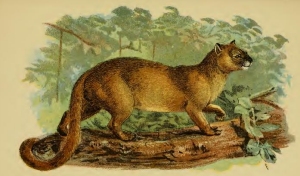Jaguarundi - the otter cat

The Jaguarundi is a small wild cat. It is not a very well-known species which for a wild cat is often not a bad thing. Unlike for example, Geoffroy's cat, the Jaguarundi does not have beautiful spots and stripes. That means that, unlike Geoffroy’s cat, the Jaguarundi is not widely hunted for its fur. Perhaps the major threat to this species is extensive logging and other human activities which threaten its habitat.
Jaguarundi can be found in the Americas from southern Texas in the USA down to northern parts of Argentina. The cat’s preferred habitat is lowland brush areas with fresh water nearby. Although most Jaguarundi prefer life in the lowlands, some have been seen high in the mountains at elevations of more than 3000 meters.
The Jaguarundi comes in two main colours - grey (in shades from black to brownish-grey)and red (in shades from foxy red to chestnut ). It was once thought that the distinct and separate colouring of the cats meant they were different species, so the grey cat was named Jaguarundi, and the red breed was called the Eyra. However it has since been discovered that different-coloured Jaguarundi cubs can even appear in the same litter.
The Jaguarundi cannot be mistaken for an average cat - there are immediate differences from the domestic Felis catus. These begin with physical appearance - the Jaguarundi has a long, muscular body, a long thick tail and disproportionally short legs. This, combined with a distinctively different facial look and tiny rounded ears, has given the Jaguarundi the very appropriate nickname of the 'otter cat'. In fact, because of its short legs the Jaguarundi runs a bit like an otter as well.
As well as a different physical appearance, the Jaguarundi also enjoy a different lifestyle. Unlike most other cats, which are either nocturnal or crepuscular (active at night or at dawn and dusk) Jaguarundi are primarily diurnal. That is, they are most active during the day.
Jaguarundi are comfortable in trees but prefer to hunt on the ground. They eat almost anything they can catch, including the usual rodents, small birds and reptiles, but these cats also fish. Most cats can swim, but most would prefer to do almost anything else. The Jaguarundi is different in having absolutely no dislike of water. It is not uncommon to see Jaguarundi living up to their ‘otter cat’ name by swimming and even diving now and again to catch a fish. This link here shows a video of a Jaguarundi as an expert fisher-cat.
Like most cats, Jaguarundi lead a solitary life. Their home range is widely variable and can be anything from 6.8 to 100 square square kilometres (2.6 to 39 sq mi). The environment and the amount of available food mainly determine the extent of a cat's home range. A comfortable environment, well-stocked with food will seldom tempt a Jaguarundi to wander far. Because Jaguarundi keep a low profile, humans are often unaware that they share a Jaguarundi’s range, and the same secretive habits of this species makes it hard for naturalists to keep track of its numbers. Farmers who intrude into a Jaguarundi's habitat often first become aware of the fact through the depletion of their poultry.
Jaguarundi have been known to respond well to humans in zoos, but are a wild species not suitable for domestication. They are extremely well-adapted to their habitat, and many have been recorded as living for over 24 years.
The nearest relative of the Jaguarundi is the cougar. However Jaguarundi are much smaller, weighing on average 3.5 to 9.1 kilograms (7.7 to 20 lb). However, the Jaguarundi is almost the same length as a small cougar, being 60 inches (152.4 cm) from head to tail, although one third of that length is the tail itself. Cougars and Jaguarundi have similar genetic structures and the same number of chromosomes, namely 38. (Most small cats have 36 chromosomes.) Interestingly, Pumas and Jaguars also have 38 chromosomes. This chromosome count is why the Jaguarundi is classified as 'Felidae', of the genus 'Puma'. The taxonomic name of the species is 'Puma jaguarundi'.
There are eight subspecies of Jaguarundi, those being: Puma yagouaroundi armeghinoi, Puma yagouaroundi cacomitli, Puma yagouaroundi eyra, Puma yagouaroundi fossata, Puma yagouaroundi melantho, Puma yagouaroundi panamensis, Puma yagouaroundi tolteca, Puma yagouaroundi yagouaroundi. The best known of these are the Puma yagouaroundi eyra found mainly in Brazil, Paraguay and Argentina; and the Puma yagouaroundi cacomitli which ranges from southern Texas to eastern Mexico. This last species is also known as a ‘gulf coast’ Jaguarundi. The reason for it becoming well-known is through the efforts of environmentalists to prevent the breed from becoming extinct because of human destruction of its habitat.

